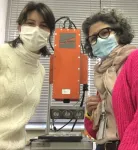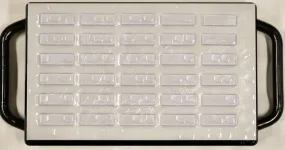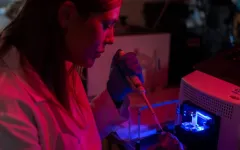(Press-News.org) An innovative method developed by an Italian team is emerging that will revolutionize the field of archaeology and radiocarbon dating and protect our cultural heritage. The researchers have used it with surprising results on archaeological bones, making the ‘invisible’ visible.
This important achievement-published in the journal Communications Chemistry of the Nature group-is the result of extensive research work coordinated by Professor Sahra Talamo, in which experts in the field of analytical chemistry from the University of Bologna and the University of Genoa collaborated.
The group has developed a new technique for analyzing archaeological bones that, for the first time, makes it possible to quantify and map at high resolution the presence of collagen, the invisible protein that is essential for making radiocarbon dates and thus obtaining new information on human evolution.
“Our results will offer significant advances for the study of human evolution,” says Talamo coauthor of the study and director of the Radiocarbon dating lab BRAVHO at the University of Bologna. “as we will be able to minimise the destruction of valuable bone material, which is under the protection and enhancement of European cultural heritage and thus allow us to contextualise the valuable object by providing an accurate calendar age.”
Many of the rarest prehistoric bones found by archaeologists are enormously precious and are considered to be part of our cultural and historical patrimony. Bones can provide a great deal of information about ancient populations’ lives: what they ate, their reproductive habits, their diseases and the migrations they undertook. However, bones cannot give us all the information we so covet. Their potential to convey information is limited by how much collagen is preserved in them.
In order to combine the need to preserve the integrity of the artifacts as much as possible with the need to carry out radiocarbon analyses, the researchers therefore developed an innovative method that, thanks to a camera coupled with near-infrared, allows them to detect the average collagen content in the observed samples.
“We used imaging technology to quantify the presence of collagen in bone samples in a non-destructive way to select the most suitable samples (or sample regions) to be submitted to radiocarbon dating analysis,” says Cristina Malegori, first author of the article and researcher at Genoa University Department of Pharmacy. “Near-infrared hyperspectral imaging (HSI) was used along with a chemometric model to create chemical images of the distribution of collagen in ancient bones. This model quantifies the collagen at every pixel and thus provides a chemical mapping of collagen content.”
It is extremely difficult, costly, and time-consuming to analyze all the bones present at one archaeological site for collagen preservation, most importantly, it would result in the destruction of valuable material. In fact, human fossils and/or bone artifacts are increasingly rarer and more precious over time. Because of the diagenetic alteration of collagen over time, large starting weights of Palaeolithic bones (≥ 500 mg bone material) are necessary to extract sufficient collagen for accelerator mass spectrometry (AMS) 14C dating (minimum 1% yield). Moreover, many of the most precious archaeological bones are too small (< 200 mg of bone material) and/or too beautiful for sampling. Therefore, obtaining preliminary, non-destructive information about the distribution of collagen on a bone sample is crucial.
It is in this context that the technique described in this study really shines because it allows obtaining information both on the location and on the content of the collagen still present in a bone sample.
“The near-infrared hyperspectral imaging camera (NIR-HSI) used in the present study is a line-scan (push-broom) system that acquires chemical images in which, for every pixel, a full spectrum in the 1,000–2,500 nm spectral range (near infrared) is recorded,” says Giorgia Sciutto, co-author of the article and professor of environmental and cultural heritage chemistry at the University of Bologna. “NIR-HSI analysis is completely non-destructive. The time required for the analysis of a single bone sample is of few minutes and, therefore, the system can examine many samples in a single day to find those suitable for analysis, saving time and money and the unnecessary waste of valuable material, greatly reducing time, costs and destruction of valuable samples.”
This technique is expected to support the selection of samples to be submitted to radiocarbon analysis at many sites where previous attempts have not been possible because of poor preservation.
“This new technique allows not only selecting the best specimens but also choosing the sampling point in the selected ones based on the amount of collagen predicted,” says Paolo Oliveri co-author of the paper and professor at the Genoa University Department of Pharmacy. “This method helps to drastically reduce the number of samples destroyed for 14C analysis, and within the bone, it helps to avoid the selection of areas that may present a quantity of collagen not sufficient for the dating. This increases the preservation of precious archaeological materials.”
“The potential of the method proposed in the present study lies in the type and amount of information that the predictive model provides, addressing two fundamental and complementary questions for the characterization of collagen in bones: how much and where,” says Cristina Malegori, first author of the article.
Thus, this experimental approach can provide quantitative information related to the average collagen content present in the whole sample submitted for investigation. The examination can be performed not only in small and localized areas (as in single-point analysis), but it can also consider the entire surface of the sample, thus producing a higher and much more significant amount of data. In addition, combining the HSI system with PLS regression allowed, for the first time, on samples of ancient bones, not only to determine the overall collagen content but also to localize it at a high spatial resolution (about 30 um), obtaining quantitative chemical maps.
“As far as radiocarbon is concerned, we could strategically sample bones of high patrimonial value. For example, knowing the precise amount of collagen concentrated in a precise area of the bone allows us to cut only this portion,” says Talamo. “Moreover when the prediction of collagen shows that the bone was poorly preserved, we can decide to perform a soft 14C pretreatment to minimize collagen loss during the extraction”.
Overall, this innovative and incisive combination of NIR-HSI spectroscopy prescreening and the radiocarbon method provides, for the first time, detailed information about the presence of collagen on archaeological bones, reducing laboratory costs by dating only materials suitable for 14C and increasing the number of archaeological bones that can be preserved, and, therefore, available for future research.
END
Protecting the cultural heritage of ancient bone artifacts is now possible. Near-infrared hyperspectral imaging and radiocarbon dating together to make the invisible visible
2023-04-11
ELSE PRESS RELEASES FROM THIS DATE:
Worldwide, those with ‘traditional’ values adhered more strictly to COVID precautions
2023-04-11
Given the battles over COVID-19 rules and recommendations in the United States over the past three years, the findings of a new UCLA-led study may come as a bit of a shock: Globally, those who professed to hold traditional values tended to adhere more closely to coronavirus-prevention measures than those who considered themselves more liberal.
“Across a wide range of countries, people who endorsed traditional cultural values — a position that often underlies socially conservative political philosophies — ...
Male yellow crazy ants are real-life chimeras
2023-04-11
The yellow crazy ant, or Anoplolepis gracilipes, has the infamous distinction of being among the worst invasive species in the world. However, this is not the reason for which this particular ant is studied by a team of international researchers. What interests them is how the insects reproduce, because males of this ant have long perplexed scientists. "The results of previous genetic analyses of the yellow crazy ant have shown that the males of this species have two copies of each chromosome. This was highly unexpected, as males usually develop from unfertilized eggs in ants, bees, and wasps – and thus should only have one maternal copy of each chromosome," explained Dr. ...
Study shows patterns of opioid prescribing linked to suicide risk
2023-04-11
Controversy surrounds the effects of policies to reduce opioid prescriptions on suicide rates. There are concerns that rapid reductions in prescription opioids might provoke increased suicide risk among people who become desparate after they are taken off opioids. According to a new study at Columbia University Mailman School of Public Health and Columbia University Irving Medical Center, however, changes in regional opioid prescribing and regional suicide rates tend to move in the same direction. This relationship held for rates of opioid prescribing, rates of high-dose prescribing and long-term prescribing, and having multiple opioid prescribers. Until ...
Assessing the accuracy of artery models
2023-04-11
Testing the material used to build models of arteries reveals their suitability for use in medical education and surgical planning.
Hokkaido University researchers have analyzed the suitability of a smooth, flexible and transparent material used to make model arteries for use in medical teaching and to plan for surgery on individual patients. Their work is described in the Journal of Vascular and Interventional Radiology.
Ever-improving 3D printing technology can create models of blood vessels that are significantly more realistic than those made with more conventional methods, and also much more suitable for surgical ...
Combination therapy overcomes BET inhibitor resistance
2023-04-11
Scientists at St. Jude Children’s Research Hospital developed a novel combination therapy approach for a leukemia subtype harboring rearrangements in the KMT2A gene. The approach overcomes the cancer’s drug resistance, without adding toxicity. The study was published today in Proceedings of the National Academy of Science.
Bromodomain and extra-terminal domain (BET) inhibitors have been shown to provide therapeutic benefits against many different cancers. However, the mechanisms governing response and resistance to this class of therapies are poorly understood.
Scientists at St. Jude conducted CRISPR ...
Maryam Baldawi named winner of the 2023 AADOCR Gert Quigley Fellowship
2023-04-11
Alexandria, VA – The American Association for Dental, Oral, and Craniofacial Research (AADOCR) has announced Maryam Baldawi as the 2023 AADOCR Gert Quigley Government Affairs Fellow.
The Gert Quigley Fellowship is designed to familiarize graduate-level students with the federal legislative process in the context of dental, oral, and craniofacial research and the oral health care delivery system. As part of the Fellowship, Baldawi will complete a short work stay at AADOCR headquarters in Alexandria, VA. She will serve a one-year term as a voting member of AADOCR’s Government Affairs Committee and as the government affairs liaison to the AADOCR National Student ...
Parathyroidectomy shows no effect on kidney function in older adults with hyperparathyroidism
2023-04-11
1. Parathyroidectomy shows no effect on kidney function in older adults with hyperparathyroidism
Subanalysis suggests the procedure may preserve kidney function in younger patients if done early
Abstract: https://www.acpjournals.org/doi/10.7326/M22-2222
URL goes live when the embargo lifts
An emulated randomized trial performed using observational data from more than 43,000 adults with primary hyperparathyroidism found that parathyroidectomy had no estimated effect on long-term kidney function in older adults when compared to observation. However, ...
Parental knowledge and attitudes toward HIV preventive treatment for their adolescent children
2023-04-11
HIV pre-exposure prophylaxis (PrEP), a daily regimen of two medications in a single pill, could prevent many new HIV infections, especially in at-risk populations. For example, research shows PrEP could prevent around 70 percent of new HIV infections in adolescent cisgender sexual minority males (ASMM) and transgender and gender diverse adolescents (TGDA), populations that are disproportionately affected by the disease. However, despite growing awareness of PrEP among ASMM/TGDA, uptake of the treatment is still less than 5 percent.
A new study published in the journal Sexuality Research and Social Policy looks ...
Texas A&M researchers discover new circuit element
2023-04-11
Dr. H. Rusty Harris, associate professor in the Department of Electrical and Computer Engineering at Texas A&M University, has identified a new circuit element known as a meminductor.
A circuit element is an electrical component used to help direct and control the flow of electricity through an electrical circuit. The classical three are known as the resistor, capacitor and inductor. Two additional circuit elements, the memristor and the memcapacitor, were only discovered in the past 15 years. These newer circuit elements are known as the mem- versions of their classical counterparts, and their current and voltage properties are dependent ...
Endocrine Society alarmed by Texas court ruling banning mifepristone
2023-04-11
WASHINGTON—The Endocrine Society is deeply concerned about a Texas ruling that reverses the U.S. Food and Drug Administration’s (FDA) approval of mifepristone, a drug used to treat Cushing’s syndrome and to end pregnancy safely and effectively.
Last week, two conflicting federal court decisions in Texas and Washington state left access to mifepristone unclear for both the treatment of Cushing’s syndrome and for medical abortions.
The Texas court ruled to ban mifepristone, taking away the FDA's authority to regulate the safety of medications. The judge paused ...





